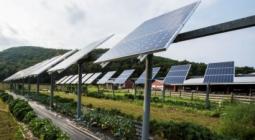So, You’ve Got 100% Renewable Energy — Now What?

Manufacturers seeking to decarbonize have a long row to hoe. They can order up a package of renewable energy and carbon offsets to power their factories and offices, but that’s just for starters. To be honest about the effort, they have to dig deeper. For some insights into the ins and outs of decarbonization, last month CleanTechnica spoke with Peder Holk Nielsen, President and CEO of the leading industrial enzyme producer Novozymes.
Seize The Renewable Energy Opportunity
The decarbonization journey that manufacturers face has many twists and turns, and renewable energy may be the easiest part to solve — at least, for businesses located in countries with advanced renewable energy policies.
That has provided Denmark-based Novozyme with an advantage.
“Our headquarters and our largest manufacturing plant are both in Denmark, where we’ve had a market for renewable electricity for more than a decade. We were one of the first companies to make a deal for wind power, and by 2011 we were entirely driven by wind power in Denmark,” Nielsen explained.
Deploy Energy Efficiency Strategically
Access to renewable energy is only part of the decarbonization pathway, though. In markets where renewable energy is still pricier than conventional fuel, companies need to make a bottom line case for switching over.
Novozymes began its wind power journey at a time when wind power in Denmark was more costly. Nevertheless, the company was able to reduce its energy costs overall by deploying energy efficiency strategically.
“We had been working on energy efficiency programs, and we made a deal with the electricity supplier to help makes us even more efficient,” says Nielsen. “For every dollar we saved on consumption, we would spend 50 cents on wind power, which was slightly more expensive. That was a very powerful engine of change. In three years we turned our whole consumption over to wind power and we were also saving money.”
No Two Countries Alike
The energy efficiency initiative exceeded the anticipated savings, and Novozymes is now applying the strategy to its global operations.
That brings up the problem of acquiring renewable energy in markets that don’t yet support renewables.
As one solution, global businesses like Novozymes have been promoting a “green industrial park” model, aimed at motivating countries to accelerate renewable energy investment by establishing special economic development zones (see wind power, Texas).
The strategy is somewhat different here in the US, where state-level policies play a critical role. Novozymes is currently working on solutions for its operations in Nebraska and North Carolina, two states that have historically had a somewhat fraught relationship with renewable energy.
Fortunately, the winds are shifting in both of those states, figuratively and literally. Theeconomic case for wind power is (finally) catching the eye of policy makers in Nebraska, and North Carolina is on the verge of tapping into its rich offshore wind resources.
Beyond Renewable Energy
Nielsen emphasizes that there is no one-size-fits-all strategy for decarbonization. Nevertheless, his overall message is that decarbonization is an opportunity, not a cost.
Those opportunities can be especially tricky to realize when companies look beyond pumping renewable energy into their offices and factories, and examine the carbon footprint within their supply chain — and their customers, too.
Novozymes has a number of significant opportunities on the customer end, because it is in the business of helping producers — in agriculture, food and beverage processing, biofuels, and other fields — maximize the efficiency of their processes.
At the UN Climate Action Summit during Climate Week 2019 in New York City last month, Novozymes outlined how it intends to go about the business of setting climate goals and meeting them in accord with the Paris Agreement.
The company emphasized setting hard targets and monitoring progress through data collection. As part of the pledge, Novzymes intends to have its progress certified by the Science Based Targets initiative. It has also been working with the UN Sustainable Development Goals framework.
Part of the commitment involves monitoring suppliers and working with them to reduce emissions related to the company’s purchase of raw materials.
At the user end, one area of focus will be transportation. Novozymes has set a 2022 target of saving 60 million tons of CO2 emissions by working with customers in the transportation sector.
Keep an eye open for more news about the company’s efforts to decarbonize its operations in the US. It will be interesting to see what the winning solution is.
10 October 2019
Clean Technica




